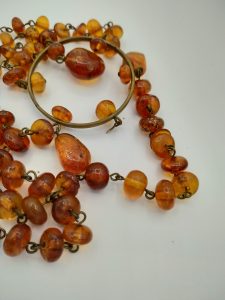On what basis amber is sorted?
This is a question, which can be answered in a number of ways. There are several factors by which amber can be sorted and defined. Lets start with the essence of Amber,amber stones are fossilized tree resin. In most cases, these stones are tens of millions of years old and the age depends on location where they are found. These stones vary in color and are found in wide range of sizes. In some cases they contain incisions of insects and other ancient life forms. This makes these stones significant for scientific research and stones with incision also are more valuable.
It is possible to define amber stone types using size, color, age and incisions. It would not be wrong to go with any of these criteria. But often it is more rational to use region of origin to define amber types. This approach also is common in most literature about Amber [1] In the following text , we are going to look at diffrent locations where amber is mined. We will explore what distinguishes stones of every location.
What are the types of Amber?
1. Baltic amber
 Baltic amber also called “Sunny stones” or “ Sun stones” is found in region of Baltics and in relatively close proximity to this region. Often after strong storms, amber stones are washed off on German, Lithuanian and Latvian sea side beaches. Most of the world’s amber comes from this regi
Baltic amber also called “Sunny stones” or “ Sun stones” is found in region of Baltics and in relatively close proximity to this region. Often after strong storms, amber stones are washed off on German, Lithuanian and Latvian sea side beaches. Most of the world’s amber comes from this regi
on, it is estimated that he number could be as high as 90% [2]. Within this region most of the amber is produced in Kaliningrad ( small region of Russia) in industrial size mine, in year 2017 they extracted record-breaking 450 tons of amber.
Baltic amber contains succinic acid which is believed to have medical properties as pain relief, this is why Baltic amber is also called succinate. One of the most popular application of pain relief properties for amber is manufacturing of teething necklaces for kids, which is believed to help with uncomfortable teething process.
Baltic Amber in most cases is found in yellow color. Every amber stone is unique and has slightly different color. The Baltic amber stones do vary in transparency. They vary from transparently yellow stones to dark non-transparent stones. One of the most sought after color is yolk yellow. Another common color for this region stones is dark yellow and brownish stones .
Baltic Amber formed about 44 million years ago. It is fascinating to have such stones in possession, especially those which has smaller or bigger inclusions. Just imagine that these inclusions were trapped 10’s of millions years ago,it is remarkable.
2. Ukrainian amber
Ukraine has a vast deposits of amber, they have about 3-5 industrial size mines which are licensed by goverment. But most of the mining in Ukraine is done illegally, the illegal mining is wide spread because of the general situation in Ukraine. Ukraine has been engaged in war with Russia for several years now, which has ramped up corruption. This makes ideal environment for illegal mining. It is hard to estimate the amount of Ukrainian amber getting to market every year, because of these illegal activities. But it is clear that the amount is impressive, some sources estimate that Ukraine is responsible for 30-40% of all the amber production in the world. I would say that this amount is fair assessment.
Most of Ukrainian amber is smuggled to other countries as Poland and afterwards sold as Baltic amber. Baltic amber and Ukrainian amber are very similar in colors and composition.
3. Dominican Amber
The most notable differences between Baltic and Dominican amber are that Dominican amber in most cases is transparent and has higher amount of inclusions. Also Dominican amber is found in more colors. Besides yellow and honey like colors, it is possible to find Dominican amber in red and green colors, which are notably rarer. Then there is the color for which Dominican amber is famous for – blue. It is interesting that it is extremely hard to see blue color with naked eye. The blue color is seen when amber is irradiated with Ultraviolet light, it exhibits fluorescence. This is the reason why many people think that all amber stones has this property, but it is not true, only Dominican Blue amber.
It is estimated that Dominican amber is between 20 and 40 million years old. It is possible that some stones are 20 and others are 40 million years old.
The market share of Dominican amber worldwide is relatively low because in most cases it is mined it small scale operations which are extremely dangerous because mining mostly takes place in dangerous holes dug by hand in ground.
4. Amber from other regions
There are other regions where amber is found in relatively small amounts. These regions are Mexico, United States and Canada. These regions and stones have small significance in amber market but it does not mean that they are not genuine and are not worth owning.
Caribbean amber, which is other name for Caribbean copal. It is softer and much younger then Baltic, Ukrainian, and Dominican amber. The oldest are few million years old , the youngest specimens are only few hundred years old. This is young age is why these stones are rarely considered amber stones but a different class of stones- copal.
